If you are like me, you have probably wondered what the Quasi amp from this thread sounds like and what all the hub-bub is about. You can either be lucky enough to have someone give you PCB's, or be very handy and etch your own like some. Then build it, and then debug, then listen.
I built the amp from a PCB given to me by BanglaH, it was tough going as it had some problems with DC offset, and these problems appear to have not been completely solved as of yet. However, the amp still sings and it has been pretty much loved by all who have built it and heard it.
So I used my experience in recording carefully-crafted sound clips from my previous 6 "Subjective Blind" driver test threads to make the following sound clips of this amp, and also compared to several other amps that I have. The conditions were identical for all amps in that the speaker, microphone, DAC (CS4398 with Burr Brown OPA2604 via USB at 48kHz), and source were all the same with the only difference being the amp was changed. There are 3 sound clips each which have been re-normalized to -3dB peak value. Sound was recorded with the same measurement mic (UMIK-1) at the measurement position as 48kHz wav files. The data was then converted to 320kbit MP3 so that it would fit as an upload to DIYA servers for you to download.
The speaker was my reference 2-way FAST with passive transient perfect cross-over and ScanSpeak 10F/8424 mid-tweeter and Dayton RS225-8 woofers in a sealed 24 liter box. The speaker is described here:
http://www.diyaudio.com/forums/full...-rs225-8-fast-ref-monitor-68.html#post4743530
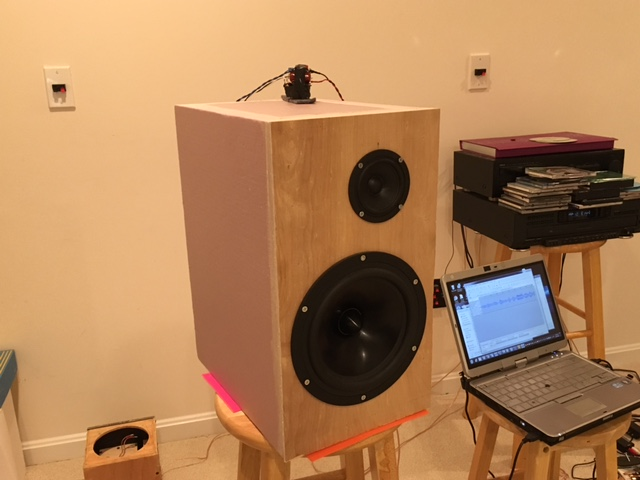
Here is measured impedance of this speaker:
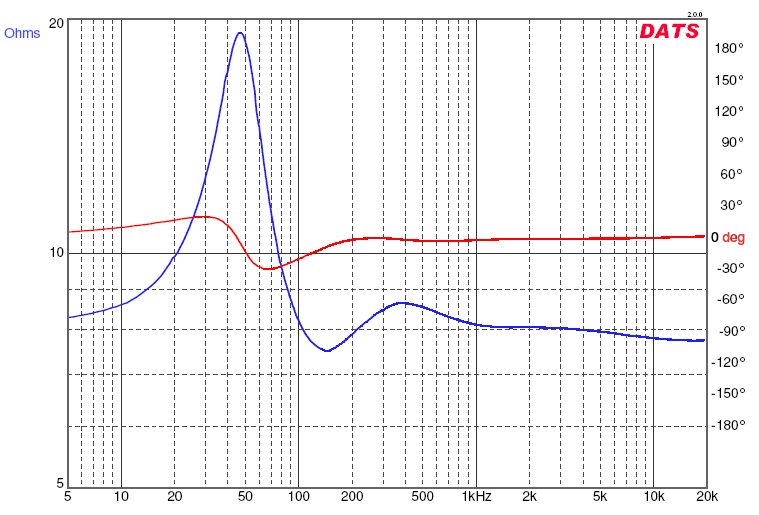
Here is my simple Quasi amp build:
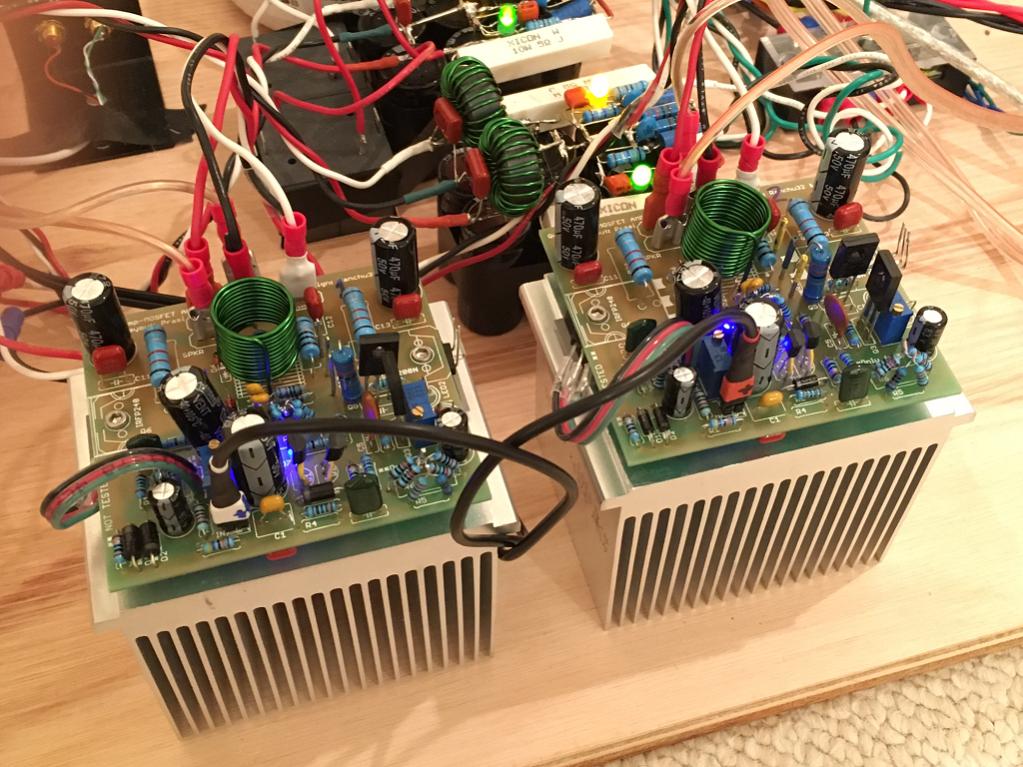
I will post the sound clips for this amp plus the following amps:
1. VHEX+ by vzaichenko (this is the only amp that used a different power supply, a 53v SMPS vs a linear 35v rail supply that all the others used in this test). This is currently my reference amp.
2. Inverted JFET Circlophone by Piersma (BJT output version)
3. Apex FX8 Bimo mod (lateral FET outputs)
4. Apex FH9 xrk971 mod (hexFET outputs)
Edit: 5. Jason K's thru hole VSSA amp (lateral FETs)
http://www.diyaudio.com/forums/solid-state/295286-virtual-audition-very-simple-quasi-mosfet-amp-5.html#post4798137
Edit: 6. Inverted JFET Circlophone with hexFET output:
http://www.diyaudio.com/forums/solid-state/295286-virtual-audition-very-simple-quasi-mosfet-amp-8.html#post4799986
Edit: 7. CFH7 amp "http://www.diyaudio.com/forums/solid-state/295286-virtual-audition-very-simple-quasi-mosfet-amp-14.html#post4811896"]http://www.diyaudio.com/forums/solid-state/295286-virtual-audition-very-simple-quasi-mosfet-amp-14.html#post4811896
Edit: 8. Pass M2 amp
Edit: 9. FH9HV with 44v rail supplies and KSA/KSC drivers vs BD139/140's - super sound quality improvement vs standard FH9.
Edit 10. F5 Juma http://www.diyaudio.com/forums/solid-state/295286-virtual-audition-very-simple-quasi-mosfet-amp-27.html
Here is the combined frequency response measured from all amps (mic and speaker untouched):
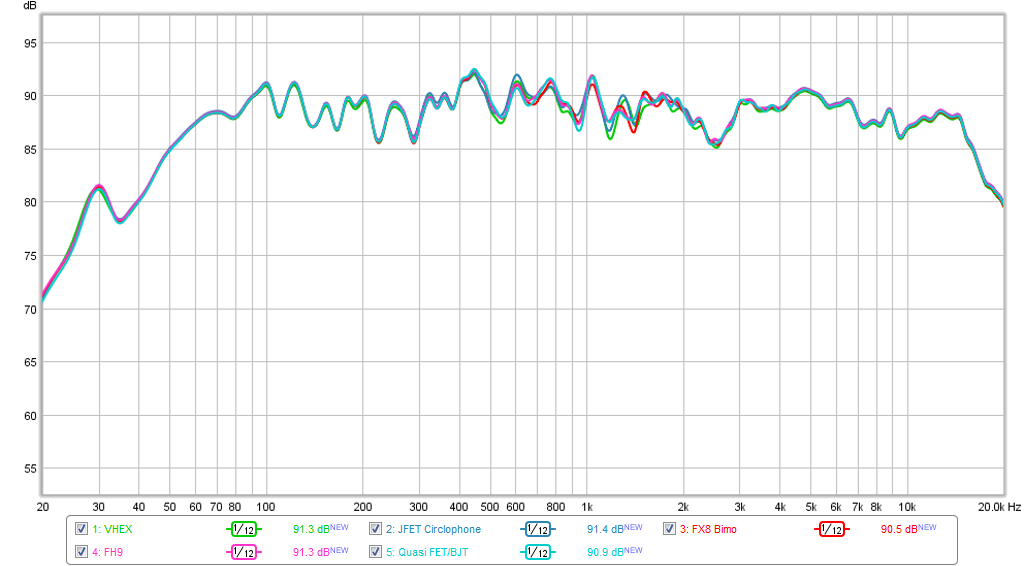
This is what the measured harmonic distortion spectrum looks like from the speaker with the Quasi amp - in general, it's lower than the speaker's HD so really doesn't intrude - but higher order distortion components vary somewhat between amps:
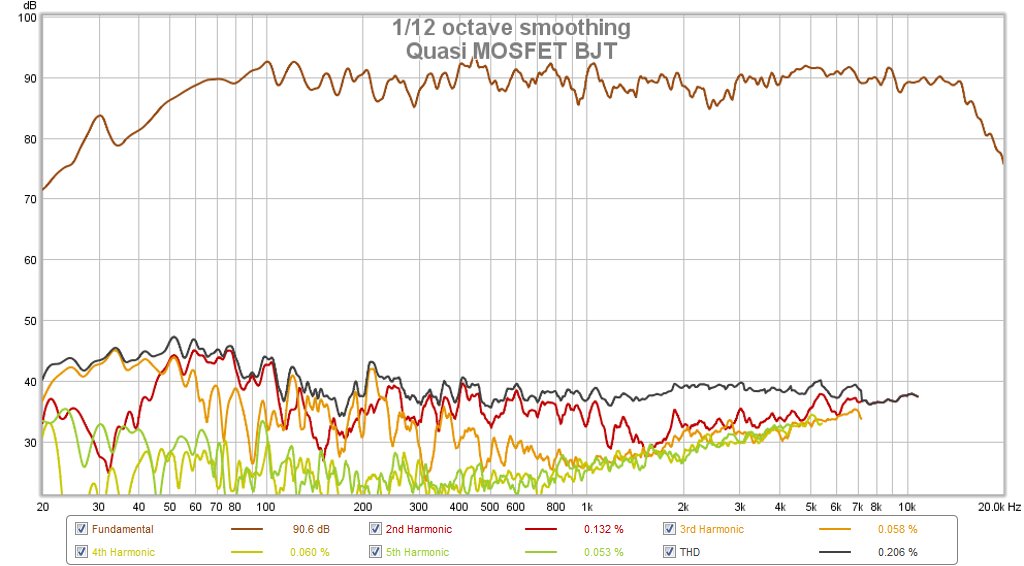
Here is the measured impulse and step response for the Quasi amp:
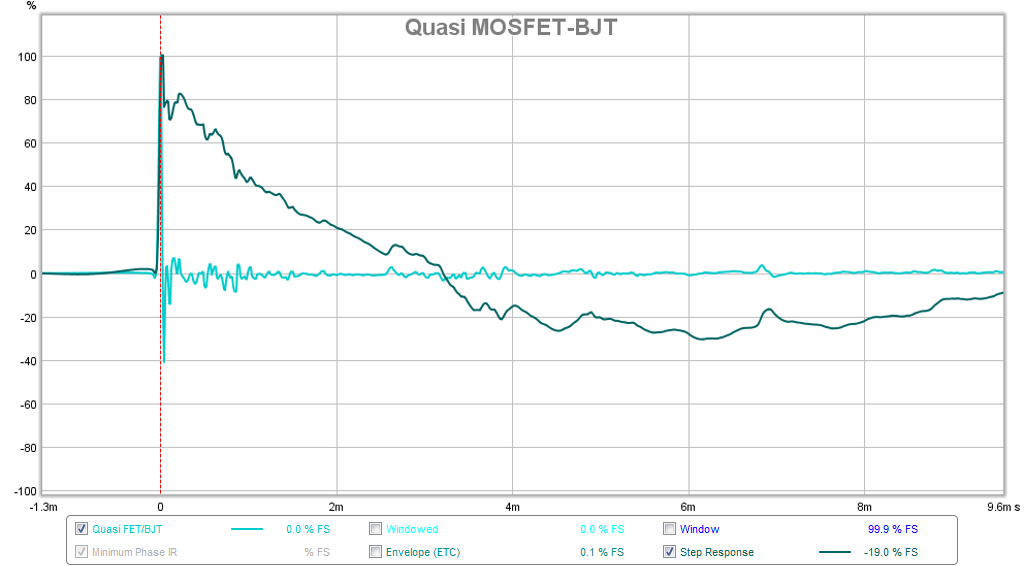
Please use good quality headphones to listen to the clips. They will have less coloration and room effects.
The three soundclips represent some high dynamic range instrumentals/jazz, pop and jazz vocals and are saved as .asc files to use the max filesize limits. Once you download it, rename the extension to .MP3 in order to listen.
Let me know what you think, or which one sounds good to you and why. Have fun!
Sound clips for Quasi amp are attached below.
Edit 8/9/2016: the sound clip sources are mono versions of their original self so that a mono setup can be used to capture both left and right channel content and not suffer from stereo layout anomalies and also to reduce room effects by having mic 0.5m away. Recording is of mono amp with single speaker with mono mic. The sound recorded precisely matches the frequency response curves presented here as the same mic at the same position was used. Ultimately, the mp3 generated is mono as well but played in both ears.
Hopefully, I will be able to post virtual audition clips for all of these amps that Inhave built:
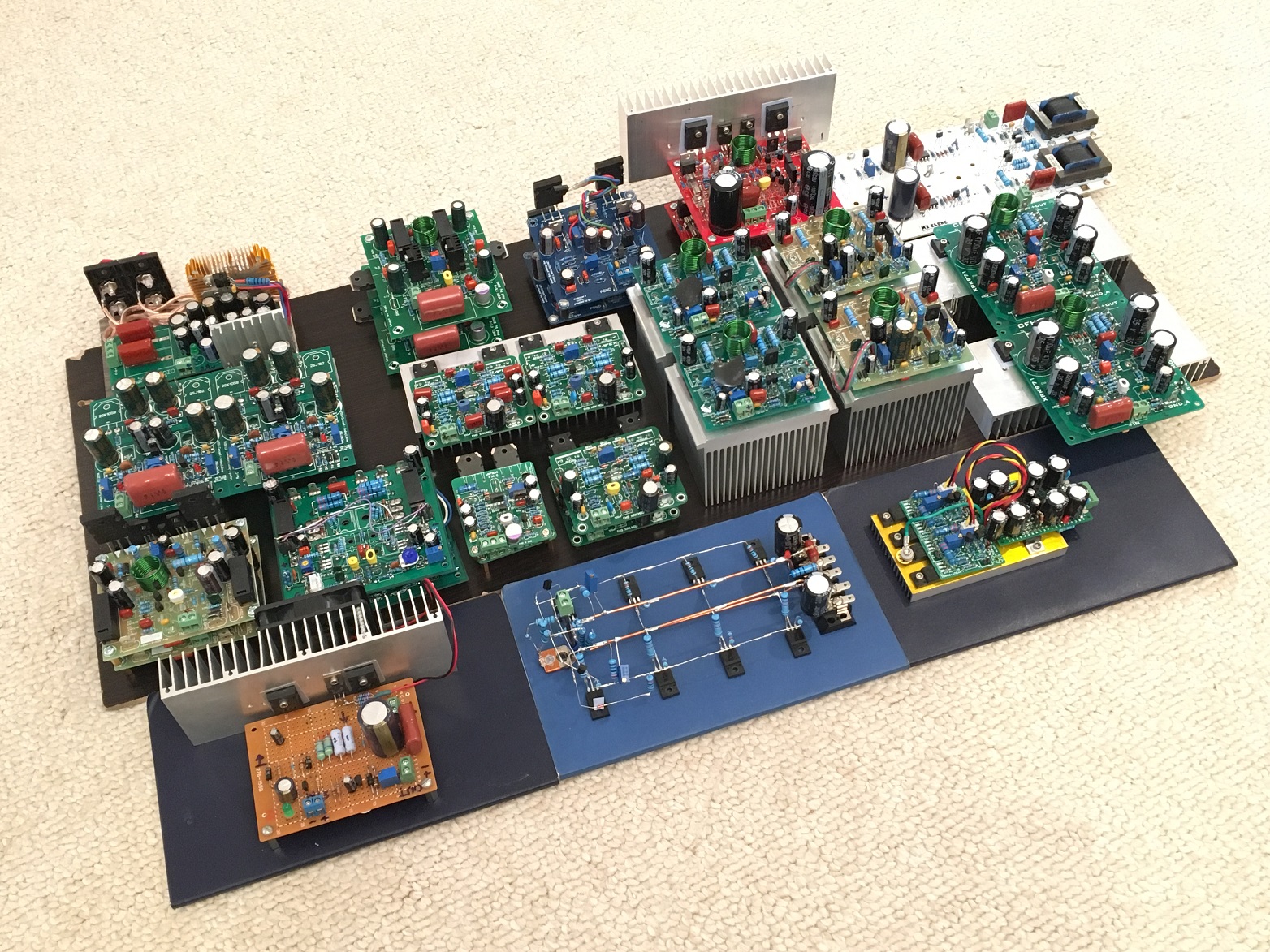
I built the amp from a PCB given to me by BanglaH, it was tough going as it had some problems with DC offset, and these problems appear to have not been completely solved as of yet. However, the amp still sings and it has been pretty much loved by all who have built it and heard it.
So I used my experience in recording carefully-crafted sound clips from my previous 6 "Subjective Blind" driver test threads to make the following sound clips of this amp, and also compared to several other amps that I have. The conditions were identical for all amps in that the speaker, microphone, DAC (CS4398 with Burr Brown OPA2604 via USB at 48kHz), and source were all the same with the only difference being the amp was changed. There are 3 sound clips each which have been re-normalized to -3dB peak value. Sound was recorded with the same measurement mic (UMIK-1) at the measurement position as 48kHz wav files. The data was then converted to 320kbit MP3 so that it would fit as an upload to DIYA servers for you to download.
The speaker was my reference 2-way FAST with passive transient perfect cross-over and ScanSpeak 10F/8424 mid-tweeter and Dayton RS225-8 woofers in a sealed 24 liter box. The speaker is described here:
http://www.diyaudio.com/forums/full...-rs225-8-fast-ref-monitor-68.html#post4743530

Here is measured impedance of this speaker:

Here is my simple Quasi amp build:

I will post the sound clips for this amp plus the following amps:
1. VHEX+ by vzaichenko (this is the only amp that used a different power supply, a 53v SMPS vs a linear 35v rail supply that all the others used in this test). This is currently my reference amp.
2. Inverted JFET Circlophone by Piersma (BJT output version)
3. Apex FX8 Bimo mod (lateral FET outputs)
4. Apex FH9 xrk971 mod (hexFET outputs)
Edit: 5. Jason K's thru hole VSSA amp (lateral FETs)
http://www.diyaudio.com/forums/solid-state/295286-virtual-audition-very-simple-quasi-mosfet-amp-5.html#post4798137
Edit: 6. Inverted JFET Circlophone with hexFET output:
http://www.diyaudio.com/forums/solid-state/295286-virtual-audition-very-simple-quasi-mosfet-amp-8.html#post4799986
Edit: 7. CFH7 amp "http://www.diyaudio.com/forums/solid-state/295286-virtual-audition-very-simple-quasi-mosfet-amp-14.html#post4811896"]http://www.diyaudio.com/forums/solid-state/295286-virtual-audition-very-simple-quasi-mosfet-amp-14.html#post4811896
Edit: 8. Pass M2 amp
Edit: 9. FH9HV with 44v rail supplies and KSA/KSC drivers vs BD139/140's - super sound quality improvement vs standard FH9.
Edit 10. F5 Juma http://www.diyaudio.com/forums/solid-state/295286-virtual-audition-very-simple-quasi-mosfet-amp-27.html
Here is the combined frequency response measured from all amps (mic and speaker untouched):

This is what the measured harmonic distortion spectrum looks like from the speaker with the Quasi amp - in general, it's lower than the speaker's HD so really doesn't intrude - but higher order distortion components vary somewhat between amps:

Here is the measured impulse and step response for the Quasi amp:

Please use good quality headphones to listen to the clips. They will have less coloration and room effects.
The three soundclips represent some high dynamic range instrumentals/jazz, pop and jazz vocals and are saved as .asc files to use the max filesize limits. Once you download it, rename the extension to .MP3 in order to listen.
Let me know what you think, or which one sounds good to you and why. Have fun!
Sound clips for Quasi amp are attached below.
Edit 8/9/2016: the sound clip sources are mono versions of their original self so that a mono setup can be used to capture both left and right channel content and not suffer from stereo layout anomalies and also to reduce room effects by having mic 0.5m away. Recording is of mono amp with single speaker with mono mic. The sound recorded precisely matches the frequency response curves presented here as the same mic at the same position was used. Ultimately, the mp3 generated is mono as well but played in both ears.
Hopefully, I will be able to post virtual audition clips for all of these amps that Inhave built:

Attachments
-
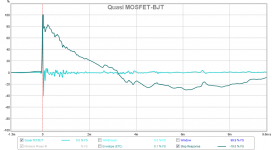 Amp-comparison-all-freq-response-IR-Quasi.png55.8 KB · Views: 6,200
Amp-comparison-all-freq-response-IR-Quasi.png55.8 KB · Views: 6,200 -
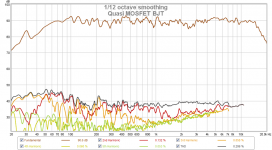 Amp-comparison-all-freq-response-HD-Quasi.png152.9 KB · Views: 6,496
Amp-comparison-all-freq-response-HD-Quasi.png152.9 KB · Views: 6,496 -
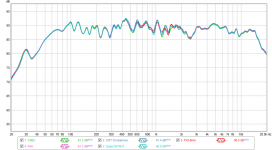 Amp-comparison-all-freq-response.png68.3 KB · Views: 6,687
Amp-comparison-all-freq-response.png68.3 KB · Views: 6,687 -
Quasi-Clip-3.asc1.8 MB · Views: 385
-
Quasi-Clip-2.asc1.7 MB · Views: 352
-
Quasi-Clip-1.asc1.7 MB · Views: 521
Last edited:
Hmmm... interesting. Listening for the clip-1 instrument, I like the FX-8 Bimo mod...
In general, the variables are (1) dynamics (2) distortion (3) richness/details (4) naturalness...
Those with good dynamics (like the hex fet amps) tend to lose details/richness and naturalness... This could be related with distortion as I found FH9 has the highest distortion (and sounds "louder" than the others)...
Those like the circlo-phone lacks dynamics...
FX8 is good in every variables. May need a reference file to know more.
In general, the variables are (1) dynamics (2) distortion (3) richness/details (4) naturalness...
Those with good dynamics (like the hex fet amps) tend to lose details/richness and naturalness... This could be related with distortion as I found FH9 has the highest distortion (and sounds "louder" than the others)...
Those like the circlo-phone lacks dynamics...
FX8 is good in every variables. May need a reference file to know more.
Last edited:
xrk971, thanks for the clips. Hands down the Quasi Mosfet-BJT has more Air, better tonality, Depth of stage and PRAT is tops. Overall, engaging from the word 'go' compared to the rest of the pack.
Hats off to the development team; Hugh's contribution here is phenomenal. Special thanks to him, despite the challenges he is facing.
Hats off to the development team; Hugh's contribution here is phenomenal. Special thanks to him, despite the challenges he is facing.
Also noticeably less sibilance, though some may hear it as a loss of sparkle in the music. Voices have more 'chest'. Dynamics are very good; the same passage sounds like 'pumping' (compression/expansion) in some of the other amps.
These are some great comments and surprising interesting results. I never got a chance to listen to the clips except coarse listening to make sure recording worked and level was about acceptable. I wonder if a Subjective Blind test would have been better to avoid bias?
Going to try this later while having a beverage. Maybe it will prove to myself that amplifiers can sound different. Never had more than one set up at one time to do AB tests.
Thank you for posting such potentially interesting stuff. 🙂
Paul
Thank you for posting such potentially interesting stuff. 🙂
Paul
Speaker impedance plot ?
.
I will run a DATS sweep of it later tonight and report back.
Going to try this later while having a beverage. Maybe it will prove to myself that amplifiers can sound different. Never had more than one set up at one time to do AB tests.
Thank you for posting such potentially interesting stuff. 🙂
Paul
Alcohol (in moderation) may actually help as you need to relax and calm the nerves. Having a quiet time is essential so late at night often works as ambient sounds are reduced. Concentration while listening is essential though.
Hmmm... interesting. Listening for the clip-1 instrument, I like the FX-8 Bimo mod...
In general, the variables are (1) dynamics (2) distortion (3) richness/details (4) naturalness...
Those with good dynamics (like the hex fet amps) tend to lose details/richness and naturalness... This could be related with distortion as I found FH9 has the highest distortion (and sounds "louder" than the others)...
Those like the circlo-phone lacks dynamics...
FX8 is good in every variables. May need a reference file to know more.
It'st interesting how even though the frequency response plots all pretty much line right up within less than 0.5dB, there are audible differences in the areas you mention above. The dynamics and distortion are quite easily discernible. Detail is somewhat compromised with a mid/tweet FAST design as it cannot compete with a dedicated soft dome tweeter or ribbon/AMT for detail that is contained above 18kHz.
I will post source reference tracks when I get back home.
Hi X! Interesting lineup, however there seems to be some issue with the channels phasing.
At least for the 1-st clip (all the amps) - I know "Impressions of Toledo" very well.
In the end of the clip, where the whole band starts playing, we should hear the rich, elastic bass. But it's eliminated here instead - this kind of thing normally happens if one of the speakers is connected with the wires exchanged - its phase is 180 degrees, comparing to the other speaker. Most of the bass almost disappears in this case.
Can you please check?
At least for the 1-st clip (all the amps) - I know "Impressions of Toledo" very well.
In the end of the clip, where the whole band starts playing, we should hear the rich, elastic bass. But it's eliminated here instead - this kind of thing normally happens if one of the speakers is connected with the wires exchanged - its phase is 180 degrees, comparing to the other speaker. Most of the bass almost disappears in this case.
Can you please check?
Hi X! Interesting lineup, however there seems to be some issue with the channels phasing.
At least for the 1-st clip (all the amps) - I know "Impressions of Toledo" very well.
In the end of the clip, where the whole band starts playing, we should hear the rich, elastic bass. But it's eliminated here instead - this kind of thing normally happens if one of the speakers is connected with the wires exchanged - its phase is 180 degrees, comparing to the other speaker. Most of the bass almost disappears in this case.
Can you please check?
Hi Valery,
Yes, you indeed know this clip well 😉
It is a 5 track! FLAC file, and I used Audacity to mix and render to to a single mono track so that all content would be played from a mono speaker. If the phase cancellation is occuring, it would be in the digital render. Or maybe I did not successfully get all 5 tracks rendered and dropped off the bass track? Let me check though - thanks for pointing it out. To be clear, the recorded clips are mono source, mono amp, single speaker, one microphone.
Right! There's some mistake in the mix then for sure.
In fact a very easy way of mixing - use foobar2000 and activate "downmix to mono" in DSP options.
Regardless of the number of channels in the source file, you will have a correct mono downmix 😎
In fact a very easy way of mixing - use foobar2000 and activate "downmix to mono" in DSP options.
Regardless of the number of channels in the source file, you will have a correct mono downmix 😎
Thanks for the tip, Valery. I don't yet have Foobar2000 - I guess it sounds like a good package to have.
Well, for the purposes of the amp, comparison, at least the same badly mixed track was used for all amps! 😀
How do the tracks sound to you?
Well, for the purposes of the amp, comparison, at least the same badly mixed track was used for all amps! 😀
How do the tracks sound to you?
- Status
- Not open for further replies.
- Home
- Amplifiers
- Solid State
- Virtual Audition of Very Simple Quasi MOSFET Amp